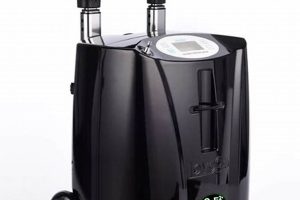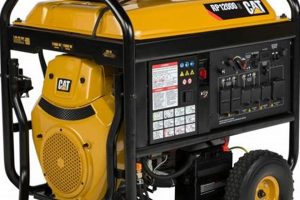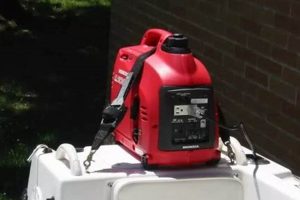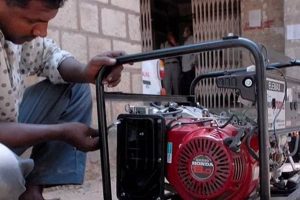Compact, independent power sources designed for minimal noise output are increasingly common for recreational activities, job sites requiring quiet operation, and emergency home power supply. These units prioritize sound reduction through features like advanced muffler design, sound-dampening enclosures, and inverter technology, resulting in quieter operation compared to conventional generators.
The reduced noise profile of these power sources offers significant advantages. In noise-sensitive environments, such as campgrounds or residential areas, they minimize disturbance to others. For professional applications, quiet operation allows for clear communication and reduces noise pollution on construction sites or during outdoor events. Furthermore, the evolution of quieter generator technology reflects growing awareness of noise pollution and its impact on health and well-being.
This article will explore key features to consider when selecting a quiet power source, including power output, fuel efficiency, runtime, and noise level ratings. It will also discuss various applications and maintenance requirements.
Tips for Selecting and Operating Quiet Portable Generators
Choosing and using a quiet generator effectively involves careful consideration of several factors. The following tips offer guidance for maximizing performance and minimizing noise impact.
Tip 1: Consider Power Needs: Accurately assess power requirements before purchasing. Overloading a generator can damage the unit and increase noise levels. Select a model that comfortably handles the anticipated load.
Tip 2: Prioritize Inverter Technology: Inverter generators generally produce cleaner power and operate more quietly than conventional models. Their variable speed control further reduces noise when full power is not needed.
Tip 3: Check Decibel Ratings: Compare decibel (dB) ratings from different manufacturers. Look for models with lower dB levels for quieter operation. Be aware that advertised dB levels may not reflect real-world performance under load.
Tip 4: Proper Placement Matters: Place the generator on a stable, level surface away from windows and doors to minimize noise transmission. Using sound-absorbing materials or barriers can further reduce noise propagation.
Tip 5: Regular Maintenance is Essential: Adhere to the manufacturer’s recommended maintenance schedule. Clean air filters, change oil, and inspect spark plugs regularly to ensure optimal performance and minimize noise output.
Tip 6: Choose the Right Fuel: Certain fuel types, like propane, can burn cleaner and produce less noise than gasoline. Explore different fuel options based on availability and generator compatibility.
Tip 7: Respect Community Noise Regulations: Be mindful of local noise ordinances, especially in residential areas or campgrounds. Operate generators during permitted hours and consider the impact on neighbors and the surrounding environment.
By following these guidelines, users can select and operate portable generators that minimize noise pollution while providing reliable power for various applications.
Following these guidelines allows for optimized generator selection and quieter operation, benefitting users and surrounding environments. Further considerations will be addressed in the article’s conclusion.
1. Sound Attenuation
Sound attenuation is crucial for achieving low decibel operation in portable generators. It involves reducing sound intensity through various methods, including absorption, dampening, and disrupting sound wave propagation. The effectiveness of these methods directly influences the perceived loudness of the generator. This is typically measured in decibels (dB), a logarithmic unit expressing sound intensity. A reduction of even a few decibels can represent a significant decrease in perceived noise. For example, a 10 dB reduction is perceived as halving the loudness.
Several techniques contribute to sound attenuation in these generators. Specialized mufflers use intricate internal geometries to redirect and absorb sound waves. Sound-dampening enclosures, constructed from materials like sound-absorbing foam and heavy-duty plastic, further contain noise emissions. Additionally, vibration isolation mounts minimize the transmission of vibrations, which can contribute to overall noise levels. Inverter technology plays an indirect role by allowing the engine speed to adjust to the power demand, reducing noise output during periods of lower load. The synergistic combination of these techniques enables manufacturers to achieve significant noise reduction. For instance, a camping generator might employ advanced mufflers and sound-dampening enclosures to minimize noise disruption in natural settings, while a generator designed for construction sites might prioritize heavier-duty sound attenuation features to cope with more demanding environments.
Understanding sound attenuation principles is essential for selecting and operating low-decibel portable generators effectively. Considering the specific sound attenuation features employed by different manufacturers enables informed purchasing decisions. Furthermore, recognizing the impact of generator placement and external factors, such as surrounding surfaces and weather conditions, allows users to optimize noise reduction in practical applications. Ongoing advancements in noise reduction technologies continue to refine sound attenuation methods, resulting in quieter and more environmentally conscious portable power solutions.
2. Inverter Technology
Inverter technology plays a crucial role in achieving low decibel operation in portable generators. Unlike conventional generators that operate at a fixed speed, inverter generators utilize advanced electronics to adjust engine speed dynamically based on power demand. This variable speed control directly impacts noise output. When less power is required, the engine slows down, reducing fuel consumption and significantly lowering noise levels. This dynamic adjustment is the core principle behind the quieter operation of inverter generators.
The impact of inverter technology on noise reduction is substantial. Conventional generators, running at a constant high speed, produce consistent, often loud, noise. Inverter generators, on the other hand, modulate engine speed, resulting in quieter operation, particularly at lower loads. Consider a scenario where a user powers a small laptop and a few LED lights. A conventional generator would continue to run at full speed, creating unnecessary noise. An inverter generator, however, would automatically lower its engine speed, producing only the power required and thus operating much more quietly. This adaptive response to power needs makes inverter generators ideal for noise-sensitive environments.
The practical significance of understanding the role of inverter technology is paramount when selecting a low-decibel portable generator. While other noise reduction techniques like mufflers and sound-dampening enclosures are essential, inverter technology addresses the root cause of much of the noise generated by traditional generators: the constant high-speed engine operation. By prioritizing models equipped with inverter technology, users can benefit from significantly quieter operation, reduced fuel consumption, and a more environmentally friendly power solution. This understanding empowers consumers to make informed choices aligned with their specific noise reduction requirements.
3. Power Output
Power output is a critical factor influencing the suitability of low-decibel portable generators for various applications. Measured in watts or kilowatts, power output determines the generator’s capacity to run electrical devices. While quiet operation is desirable, it shouldn’t compromise the ability to power necessary equipment. The required power output depends heavily on the intended use. For instance, powering sensitive electronics during a camping trip requires significantly less power than operating power tools on a construction site. Selecting a generator with inadequate power output can lead to overloads, potentially damaging both the generator and connected devices. Conversely, choosing a generator with excessive power output for the intended application results in inefficient fuel consumption and potentially higher operating costs.
Matching power output to specific needs is essential for efficient and effective operation. Calculating the combined wattage requirements of all devices intended for simultaneous use is crucial. This calculation allows for accurate generator selection, ensuring sufficient power without unnecessary excess. Consider a scenario involving a construction crew needing to power several power tools simultaneously. Accurately assessing the combined wattage draw of these tools enables selection of a generator with adequate power output. This prevents overloads and ensures uninterrupted operation. Conversely, a camper powering a laptop and a small refrigerator requires significantly less power output. Selecting a smaller, more fuel-efficient generator tailored to these needs provides adequate power while minimizing weight, noise, and fuel consumption. These real-world examples demonstrate the importance of careful power output consideration.
Understanding the relationship between power output and low-decibel operation is essential for informed generator selection. Balancing the desire for quiet operation with the necessity for sufficient power delivery is key. Oversizing a generator for a given application, while potentially providing a margin of safety, can result in unnecessary noise and fuel consumption. Conversely, undersizing a generator leads to overloads and potential equipment damage. Therefore, careful consideration of power requirements ensures that the selected generator meets operational needs while minimizing noise pollution and operating costs. This thoughtful approach contributes to both efficient power delivery and environmental responsibility.
4. Fuel Efficiency
Fuel efficiency is a significant consideration for low-decibel portable generators, impacting both operational costs and environmental impact. Efficient fuel consumption reduces operating expenses and minimizes the generator’s carbon footprint. Inverter technology plays a key role in enhancing fuel efficiency. By adjusting engine speed to match power demand, inverter generators consume less fuel, particularly under lighter loads, compared to conventional generators that operate at a fixed speed regardless of power draw. This variable speed control optimizes fuel usage, leading to cost savings and reduced emissions.
The practical implications of fuel efficiency extend beyond economic considerations. Reduced fuel consumption translates to longer runtimes on a single tank, enhancing convenience and operational flexibility. For instance, a fuel-efficient generator can power essential appliances during an extended power outage or provide reliable power for a camping trip without frequent refueling. Moreover, lower fuel consumption minimizes environmental impact by reducing greenhouse gas emissions. This aspect is particularly relevant in eco-conscious applications where minimizing environmental disruption is a priority. Consider a remote research station relying on a portable generator for power. A fuel-efficient model minimizes the frequency of fuel deliveries, reducing logistical complexities and minimizing the environmental impact associated with fuel transportation.
Careful consideration of fuel efficiency is essential when selecting a low-decibel portable generator. While noise reduction remains a primary concern, fuel efficiency contributes significantly to overall operational effectiveness and environmental responsibility. Prioritizing models with high fuel efficiency ratings, often expressed as gallons per hour (GPH) or liters per hour (LPH) at various load levels, ensures cost-effective operation and minimizes environmental impact. Understanding the relationship between fuel efficiency and inverter technology empowers consumers to make informed decisions aligned with both practical needs and environmental considerations. This comprehensive approach facilitates selection of generators that optimize performance, minimize operating costs, and promote sustainable power generation.
5. Portability
Portability is a defining characteristic of low-decibel portable generators, directly influencing their usability and suitability for various applications. The portability of these generators stems from their compact design, lightweight construction, and integrated features like handles and wheels. This facilitates easy transport and maneuverability, allowing users to deploy power wherever needed. The interplay between portability and noise reduction is significant. Quiet operation expands the range of suitable environments for generator use, including noise-sensitive areas like residential neighborhoods and campgrounds. This broadened applicability enhances the value of portability, enabling use in situations where traditional, louder generators would be impractical or disruptive. For instance, a portable, low-decibel generator can provide power for a tailgate party without disturbing nearby attendees or offer backup power during a camping trip without disrupting the tranquility of the natural setting. These scenarios demonstrate the practical significance of the connection between portability and quiet operation.
The practical advantages of portability extend to professional applications. Contractors, event organizers, and emergency responders benefit from the ability to quickly deploy quiet power in various locations. Imagine a film crew operating in a remote location requiring power for lighting and sound equipment. A portable, low-decibel generator offers a practical solution, providing reliable power without disrupting the filming process or impacting the natural soundscape. Similarly, disaster relief efforts often rely on portable generators to provide essential power in affected areas. Quiet operation is crucial in these scenarios, minimizing disruption for residents and facilitating communication among responders. These real-world examples illustrate the value of portability in diverse professional contexts.
Effective integration of portability and low-decibel operation is crucial for maximizing the utility of these generators. Balancing weight and size with power output and noise reduction requires careful design considerations. Furthermore, incorporating features like ergonomic handles, durable wheels, and compact enclosures enhances portability without compromising functionality or quiet operation. Understanding the connection between portability and low-decibel operation is fundamental for selecting the appropriate generator for specific applications. This understanding empowers users to choose generators that meet their power needs while minimizing noise pollution and maximizing ease of transport and deployment in various environments.
6. Maintenance
Regular maintenance is crucial for preserving the low-decibel operation and overall performance of portable generators. Neglecting routine maintenance can lead to increased noise levels, reduced efficiency, and potentially costly repairs. Several factors contribute to this connection. A clogged air filter, for example, restricts airflow to the engine, forcing it to work harder and produce more noise. Similarly, worn spark plugs can disrupt combustion, leading to rough engine operation and increased noise output. Furthermore, neglecting oil changes can result in increased friction and wear within the engine, contributing to higher noise levels and reduced engine lifespan. Addressing these maintenance needs proactively is essential for sustaining quiet operation.
The practical significance of regular maintenance extends beyond noise reduction. Proper maintenance ensures optimal fuel efficiency, maximizing runtime and minimizing operating costs. For instance, a clean air filter and properly gapped spark plugs contribute to efficient combustion, optimizing fuel consumption. Furthermore, regular oil changes protect the engine from excessive wear, extending its lifespan and preventing costly repairs. Consider a contractor relying on a portable generator to power tools on a construction site. Consistent maintenance ensures reliable operation, minimizing downtime and maximizing productivity. Conversely, neglecting maintenance could result in equipment failure, project delays, and increased expenses. This example illustrates the practical impact of maintenance on professional applications.
Understanding the direct link between maintenance and sustained low-decibel operation is essential for responsible generator ownership. Adhering to the manufacturer’s recommended maintenance schedule, including regular air filter cleaning or replacement, spark plug inspection and replacement, and timely oil changes, preserves quiet operation and maximizes the generator’s lifespan. Neglecting these tasks can lead to increased noise pollution, reduced efficiency, and potentially irreversible engine damage. Therefore, prioritizing routine maintenance ensures that low-decibel portable generators continue to provide reliable, quiet power for various applications while minimizing environmental impact and maximizing operational lifespan.
Frequently Asked Questions
This section addresses common inquiries regarding low-decibel portable generators, providing concise and informative responses.
Question 1: How is the noise level of a generator measured?
Generator noise is typically measured in decibels (dB). Lower dB ratings indicate quieter operation. Manufacturers often provide dB ratings at a specified distance, such as 23 feet (7 meters). It’s important to compare dB ratings under similar conditions to accurately assess relative noise levels.
Question 2: What makes an inverter generator quieter than a conventional generator?
Inverter generators utilize variable speed control, adjusting engine speed to match power demand. This results in quieter operation, particularly at lower loads, compared to conventional generators that operate at a fixed speed. Additionally, inverter generators often incorporate advanced mufflers and sound-dampening enclosures to further minimize noise output.
Question 3: Are low-decibel generators suitable for powering sensitive electronics?
Many low-decibel generators, particularly those with inverter technology, produce clean and stable power suitable for sensitive electronics like laptops, smartphones, and medical devices. However, it’s essential to verify the generator’s power quality specifications before connecting sensitive equipment.
Question 4: What factors affect the runtime of a low-decibel generator?
Runtime depends on factors including fuel tank capacity, power output, and the load placed on the generator. Higher power demands and heavier loads reduce runtime. Fuel efficiency also plays a significant role, with more fuel-efficient models generally offering longer runtimes on a single tank.
Question 5: How can noise output be further minimized during operation?
Placing the generator on a stable, level surface away from reflective surfaces like walls and buildings can reduce noise reflection and propagation. Using sound-absorbing materials or barriers can further dampen noise. Maintaining proper clearance around the generator for adequate ventilation also contributes to quieter operation.
Question 6: What maintenance is required for a low-decibel portable generator?
Regular maintenance, including air filter cleaning or replacement, spark plug inspection and replacement, and oil changes, is essential for preserving quiet operation and maximizing generator lifespan. Refer to the manufacturer’s recommendations for specific maintenance intervals and procedures.
Addressing these common questions provides a foundation for informed decision-making regarding low-decibel portable generators. Understanding these key aspects empowers consumers to select the appropriate generator for their specific needs and prioritize quiet operation without compromising power delivery or reliability.
The subsequent sections will explore specific models and delve deeper into the practical applications of low-decibel portable generators.
Conclusion
This exploration has highlighted the multifaceted nature of low-decibel portable generators, emphasizing their increasing importance in diverse applications. From recreational activities to professional work sites and emergency preparedness, the demand for quiet, reliable power sources continues to grow. Key considerations such as sound attenuation technologies, inverter technology’s impact on noise reduction and fuel efficiency, power output requirements, portability advantages, and the essential role of maintenance in preserving quiet operation have been thoroughly examined. The convergence of these factors underscores the value proposition of these generators, offering a compelling alternative to traditional, noisy power solutions.
As technological advancements continue to refine noise reduction techniques and enhance fuel efficiency, low-decibel portable generators are poised to play an even more prominent role in meeting evolving power needs. The ongoing pursuit of quieter, more environmentally conscious power solutions positions these generators as essential tools for individuals, businesses, and communities seeking reliable power without compromising tranquility or environmental responsibility. Careful consideration of the factors outlined herein empowers informed decision-making, ensuring selection of the optimal generator to meet specific power requirements while minimizing noise pollution and maximizing operational efficiency. This informed approach fosters a harmonious balance between power accessibility and environmental stewardship.






